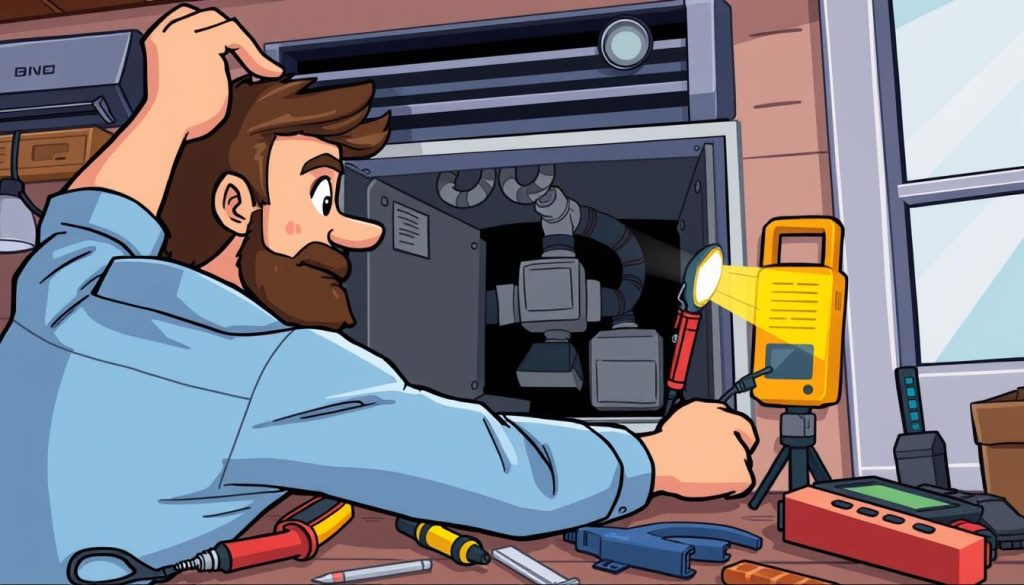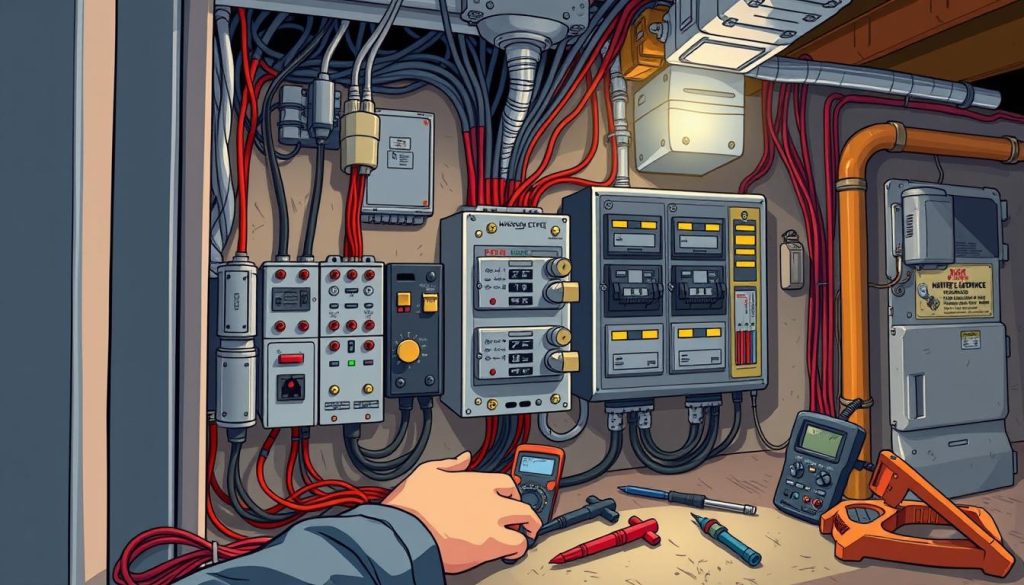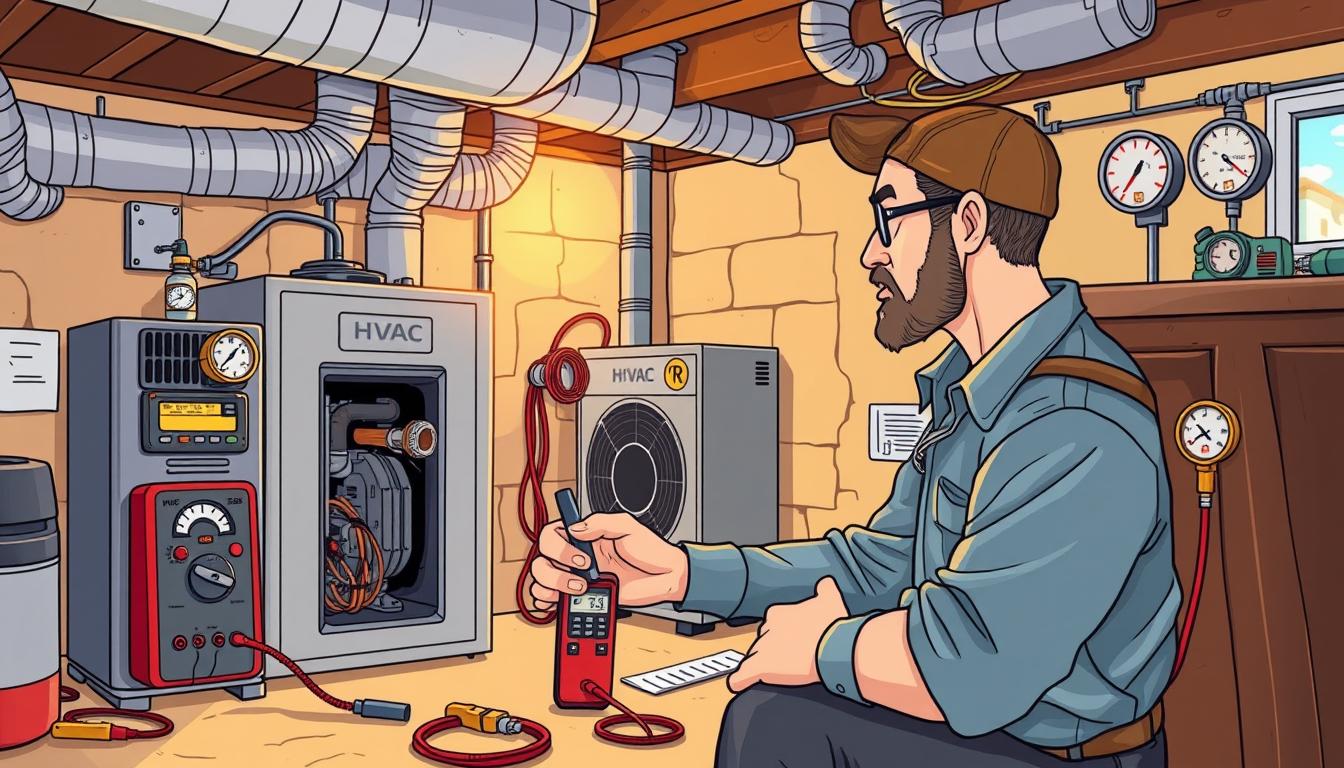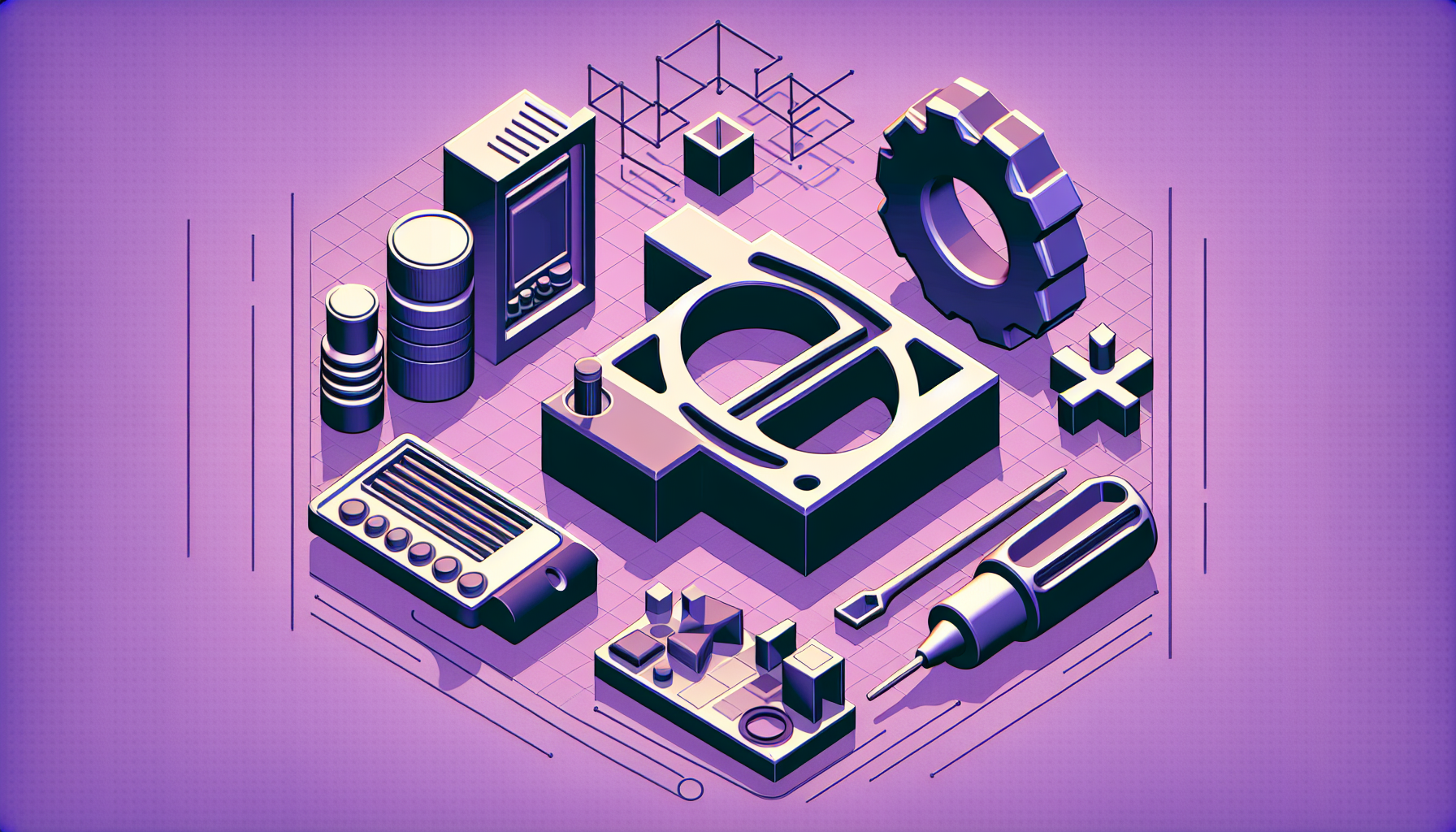Keeping your HVAC system in top shape is key for a cozy home and saving on energy bills. A self-inspection is a smart move to manage your heating, ventilation, and air conditioning (HVAC) system. By checking your HVAC system’s parts, you can spot problems early and fix them fast. This keeps your home’s climate control working well.
Key Takeaways
- Regular HVAC self-inspections can help you identify and address issues before they escalate into costly repairs.
- Checking the thermostat, cleaning the outdoor and indoor units, and inspecting the electrical components are essential steps in the self-inspection process.
- Maintaining proper refrigerant levels and airflow is crucial for your HVAC system’s efficiency and longevity.
- Leveling and stabilizing the HVAC unit can improve its performance and prevent further damage.
- DIY HVAC self-inspections can save you money on professional service visits and help you become more informed about your home’s climate control system.
Understanding the Importance of HVAC Self-Inspection
Regular HVAC self-inspections are key for keeping your efficiency, lifespan, and indoor air quality top-notch. Preventative maintenance helps spot and fix issues early, saving you money on energy and repairs. A detailed inspection ensures your HVAC system works best, especially during peak seasons.
Ignoring maintenance can harm your system’s energy efficiency, indoor air quality, and lifespan.
Why Regular HVAC Maintenance is Crucial
Regular HVAC checkups and upkeep bring many benefits:
- Boosts energy efficiency and cuts down utility bills
- Increases your HVAC system’s lifespan
- Improves indoor air quality and comfort
- Spot and fix potential issues before they get worse
- Makes sure your system runs at optimal performance
Investing in preventive HVAC maintenance means a well-working system. It also means avoiding expensive fixes or early replacements. Regular self-inspections are vital for your HVAC system’s health.
Preparing for the Self-Inspection Process
Before starting your HVAC self-inspection, it’s important to prepare well. This ensures a thorough and efficient check. Follow these simple steps to assess your home’s HVAC system well and find any issues early.
- Turn Off the Power – First, turn off the power to both indoor and outdoor HVAC units. This step is crucial for safety and lets you inspect without risk of electric shock.
- Gather the Necessary Tools – Get all the tools you need, like a screwdriver, flashlight, and garden hose. Having these ready makes the inspection easier and more thorough.
- Clear the Outdoor Unit Area – Check the outdoor unit area and remove any debris or plants that block airflow. Keeping this area clear is key for your system’s efficiency.
By preparing well for your HVAC self-inspection, you can do a detailed check of your system. This proactive step helps you spot problems early and keep your HVAC running well.
| Task | Importance |
|---|---|
| Turn off power supply | Ensures safety and allows for safe inspection |
| Gather necessary tools | Streamlines the inspection process |
| Clear outdoor unit area | Maintains proper airflow and system performance |
What to Do Before Starting the HVAC Self-Inspection?
To prepare for your HVAC self-inspection, follow a few key steps. First, turn off the power to both units for safety. Then, collect all the tools you’ll need, like a screwdriver and flashlight. Lastly, clear the outdoor unit area of debris to ensure good airflow.
Checking the Thermostat Functionality
As a homeowner, checking your thermostat is a key first step. This part is vital for controlling your HVAC system’s temperature. By testing HVAC thermostat operation, assessing thermostat settings, and verifying thermostat calibration, you can make sure your system works well.
Thermostat Troubleshooting Tips
Start by making sure your thermostat is set to the right temperature. Check if it’s turning on the heating or cooling as it should. If you have a smart or programmable thermostat, check its settings to see if they’re right. This helps you assess thermostat operation and spot any problems.
It’s also important to calibrate your thermostat correctly. Use a digital thermometer to test HVAC thermostat accuracy and adjust settings if needed. This small step can save energy and keep your home cozy.
If your thermostat isn’t working right, it might need fixing or replacing. A bad thermostat can cause uneven temperatures, higher energy bills, and damage to your HVAC system. Fixing thermostat problems quickly ensures your HVAC system works its best.
| Thermostat Functionality Checklist | Verified |
|---|---|
| Thermostat set to desired temperature | ✓ |
| Thermostat triggering heating/cooling mode | ✓ |
| Programmable thermostat settings correct | ✓ |
| Thermostat calibration checked | ✓ |
| No thermostat malfunctions detected | ✓ |
How to self inspect HVAC?
Doing a DIY HVAC check is a smart move to keep your home’s heating, ventilation, and air conditioning system in top shape. By following a simple guide, you can check your HVAC unit’s condition and fix problems early. Let’s look at the main steps for this self-check.
Step-by-Step Guide to DIY HVAC Inspection
First, turn off the power to both the indoor and outdoor HVAC units. This keeps you safe while you inspect. Then, clean the outdoor unit by removing any dirt or blocks that might stop airflow. Use a soft brush or a garden hose to clean the fins and coils carefully.
Make sure the outdoor unit is level and adjust it if needed. This helps airflow and makes the unit work better. Inside, clean the evaporator coil with a coil cleaner. Also, check the drain pan to avoid water leaks.
- Change the air filters as the maker suggests. Dirty filters can slow down airflow and make your system less efficient.
- Look at the electrical parts, like wiring, capacitors, and contactors, to make sure they’re working right.
- Check the ductwork for leaks or damage and fix it if you find any.
- Test the thermostat to make sure it’s controlling the temperature right and that your HVAC system is working as it should.
By doing this detailed DIY HVAC check, you can find and fix problems early. This makes your system work better and last longer. Remember, regular upkeep is crucial for a well-functioning HVAC unit and comfortable home climate.

Outdoor Unit Inspection
It’s key to keep your HVAC outdoor unit in top shape for better climate control and saving energy. Start by inspecting the HVAC outdoor unit well. It’s outside and can get dirty, which can block airflow and lower performance.
Clearing Debris and Maintaining Airflow
First, take off the protective cage or cover from the outdoor unit. Use a wet/dry vacuum to clean out leaves, sticks, and other stuff from inside. Then, spray the fins with a garden hose to clean them. Use a butter knife or a fin-straightening tool to fix any bent fins.
It’s vital to keep the area around the HVAC outdoor unit clear for good airflow around the HVAC system. Cut back any plants or remove things that block airflow. A clean area helps your system work better and last longer.
| Task | Importance |
|---|---|
| Inspecting HVAC outdoor unit | Ensures the unit is free of debris and operating at optimal efficiency. |
| Cleaning HVAC condenser | Maintains the condenser coils, enhancing heat transfer and cooling performance. |
| Maintaining airflow around HVAC system | Allows for proper circulation, preventing overheating and improving energy usage. |
| Removing debris from HVAC unit | Prevents clogging and ensures unobstructed airflow, extending the system’s lifespan. |
| Importance of HVAC unit clearance | Ensures adequate space for ventilation, cooling, and efficient operation. |
Leveling and Stabilizing the HVAC Unit
Keeping your HVAC outdoor unit level and stable is key for its best performance. Ground shifts or environmental changes can make your HVAC condenser unleveled. This can cause early compressor failure and expensive fixes. It’s vital to check your unit’s leveling during your HVAC self-inspection and take steps to stabilize it.
To make sure your HVAC system is leveled and stabilized, follow these easy steps:
- Use a high-quality spirit level to see if the outdoor unit is perfectly level. Place the level on the top of the unit and check if the bubble is centered.
- If the unit is not level, use rot-resistant shims to lift the low side. This will help prevent HVAC unit shifting and keep the compressor and other parts aligned.
- After leveling, check if the base or platform is stable. If it wobbles or feels unstable, add more shims or concrete blocks to stabilize the HVAC system.
Regularly leveling and stabilizing your HVAC outdoor unit is a crucial maintenance task. It can greatly improve the efficiency and lifespan of your heating and cooling system. By ensuring your HVAC condenser is perfectly level and secure, you enhance your HVAC equipment’s performance and reliability.
Indoor Unit Inspection
It’s key to check and keep the indoor HVAC parts in good shape. Start with the evaporator coil and air filters. These are crucial for clean air and system work.
Cleaning the Evaporator Coil
The evaporator coil in the indoor unit gets dirty, which hurts airflow and system efficiency. Use a no-rinse coil cleaner to clean it. Make sure to also clean the drain pan and check the condensate drain line.
Replacing the Air Filters
- Dirty air filters hurt your HVAC system’s performance. They can cause less airflow, lower efficiency, and damage to parts.
- Change the air filters as the maker suggests, usually every 1-3 months. This depends on how much you use it and your environment.
- Use the right filter size and type for your HVAC model. This keeps the air inside clean and your system working well.
By inspecting the HVAC indoor unit, cleaning the evaporator coil, and replacing the air filters often, you keep your HVAC system running smoothly. This is important for clean air and system performance.
Checking the Electrical Components
Keeping your HVAC system’s electrical parts in good shape is key for it to work right and safely. When you do a self-check, make sure to look at the wiring, capacitors, and contactors for any damage. Checking that all electrical connections are tight and safe helps your HVAC system last longer and keeps you safe.
Inspecting HVAC Wiring and Connections
First, check the wiring that connects your HVAC unit to power. Look for fraying, cracking, or loose connections. Make sure all wires are well-insulated and not exposed. If you find any wiring problems, get a pro HVAC tech to fix it fast.
Testing HVAC Capacitors and Contactors
Capacitors and contactors are vital for your HVAC system. Capacitors store energy and help start the motor. Contactors switch the system on and off. Test these parts to make sure they work right. If you see damage or wear, like bulging or corrosion, replace them.
Importance of HVAC Electrical Maintenance
Regular HVAC electrical maintenance keeps your system efficient and safe. Ignoring electrical parts can cause problems like low energy efficiency, system breakdowns, and fire risks. By checking and fixing electrical issues, you can avoid these problems and make your HVAC system last longer.
Inspecting HVAC Safety Features
Your HVAC system has safety features like limit controls and surge protectors. During your self-check, make sure these features work right. Test the limit controls to see if they turn off the system when it gets too hot. Also, check the surge protector to see if it’s protecting against power surges.

By carefully inspecting the electrical components of your HVAC system, you can spot and fix problems early. Always put safety first and get a pro HVAC technician if you’re unsure about your system’s electrical health.
Refrigerant Level and Airflow Inspection
The last step in your HVAC self-inspection is checking refrigerant levels and airflow. It’s key to keep your system running well and saving energy. This ensures your heating, ventilation, and air conditioning (HVAC) system works at its best.
Why is Checking Refrigerant Levels Important?
Low refrigerant levels can mean a leak, hurting your HVAC’s efficiency and costing you money. Use a refrigerant gauge to check levels against the manufacturer’s specs. If it’s low, fix it fast to avoid more damage.
How to Test HVAC System Airflow?
Good airflow is vital for your HVAC’s efficiency. Blockages in ducts can cause uneven temperatures and higher bills. Use a digital airflow meter to check each register’s airflow against the manufacturer’s standards.
Signs of HVAC Refrigerant Leaks
- Reduced cooling or heating output
- Higher than normal energy bills
- Hissing or bubbling sounds from the HVAC unit
- Ice buildup on the evaporator coil
Importance of Proper Refrigerant Charge
The right refrigerant charge is crucial for good airflow. Too little refrigerant makes the system work harder, using more energy and shortening the compressor’s life. Too much refrigerant can also cause problems and damage components.
| HVAC Component | Optimal Refrigerant Level | Impact of Improper Charge |
|---|---|---|
| Compressor | Manufacturer Specified | Increased wear and potential failure |
| Condenser Coil | Manufacturer Specified | Reduced heat transfer efficiency |
| Evaporator Coil | Manufacturer Specified | Decreased cooling capacity and airflow |
If you think there’s a refrigerant leak or airflow problem, call a professional HVAC technician. They can diagnose and fix the issue. Keeping your HVAC’s refrigerant levels and airflow in check will make it last longer, save energy, and keep your home comfortable.
Conclusion
Doing a detailed HVAC self-inspection can keep your heating and cooling system running well. It helps you spot and fix small problems before they get big. This way, you can avoid expensive repairs and save on energy bills.
But, it’s smart to know when to ask for help from a pro. If you face complex issues or need special tools, it’s best to call a technician. Taking care of your HVAC system yourself can make your home comfy and energy-smart all year.
Regular HVAC checks offer many benefits. They make your system work better, cut down on energy costs, and make your equipment last longer. With the guide from this article, you can do a DIY check easily. This way, you can take good care of your HVAC system with confidence.





0 Comments